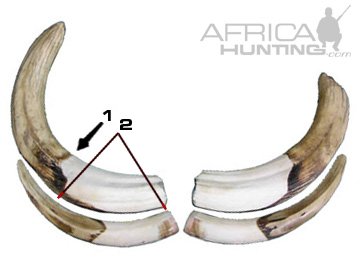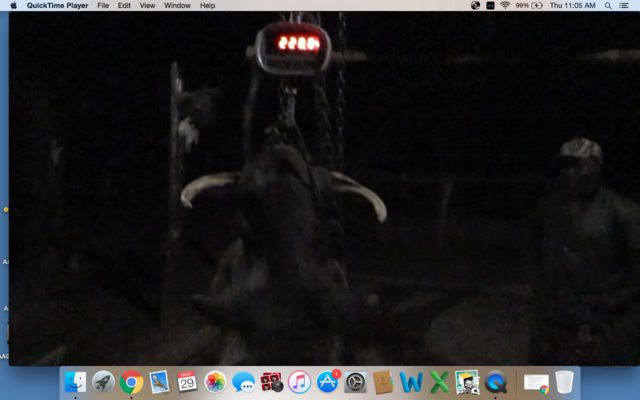- Joined
- Oct 1, 2007
- Messages
- 13,077
- Reaction score
- 9,171
- Website
- www.africahunting.com
- Media
- 5,597
- Articles
- 321

01. One of my favorite road signs.
When discussing hog tusk measurement here I refer to tusk length for a hog in it's simplest form which is taking the measurement of the longest upper tusk starting from the base, which is found inside the facial bone, along the outside of the tusk to the tip only. Even though hogs have two sets of tusks, the upper and lower, only the larger upper tusks are measured for official measurement purposes, as the lower teeth are hard to see or evaluate in the field. This, of course, is a basic method but for a primer on How To Measure Your Trophies you can read AfricaHunting.com article by clicking here.
The name hog comes from the like protrusions found on the head of the animal, which serve the purpose of defense to protect the eyes especially when males fight.
When side by side, a mature hog will stand out in comparison to a sow body wise, with a larger body and head, however the size of the boar is not an indication of the size of the tusks.
While judging hog, body size does not play a role and is not an aspect to assess as to the maturity of a possible trophy. When they get old, their body mass declines with age and the smaller the body may become.
The most significant factor to look at to differentiate between a hog male and a sow is the s on their face. Both will have the set of s on the side of the face right below the eyes, however the male hog will have another set of s above the upper tusks along the muzzle that the sow will not have.
Most often, mature hog males will have upper tusks that are thicker and more impressive looking compared to sows upper tusks that are thinner with a tendency to have tighter curls that come inward quickly, sometimes achieving a heart shape, rather than outward and upward like boars. Although sow tusks can on occasion be quite impressive they are rarely hunted as a trophy.
02. Here you can clearly differentiate a mature male to the left
with a mature female to the right.
03. Here is an example of a mature sow carrying impressive
tusks which could easily be mistaken for a mature boar at first
glance. Notice the smaller size of the s below the eyes, the
lack of a second set of s above the tusks and last but not
least the thinner teeth that have tighter curls and come inward
quickly.
04. Here is an example of a mature sow with heart shaped
tusks, a clear sign that it is a female.
05. Mature sow carrying impressive tusks.
06. A mature male hog that clearly shows the four s
which develop and grow in size with age. However the size of the
s are not a reliable indication of age as you will find some
hogs with relatively small s compare to others.
07. Very nice mature male hog with relatively small
like protrusion.
left tusk 10.62 inch (27 cm) - left base 4.72 inch (12 cm)
08. A young immature hog which clearly shows the four
s. A larger set of s easily visible below the eyes and a
second set on the side of the muzzle just above the upper tusks
a clear indication of a male. The tusks will develop and grow
more outward from this stage.
09. Here is an example of a young sow carrying smaller inward
tusks. Even at this stage of development you can see the
difference between the male (above) and female tusks.
10. hog males can also be identified by their testicles
easily visible from the back.
11. Young male hog on the right. On the left, an even
younger hog showing along his muzzle blond whiskers
which can be mistaken at some angles for the upper tusks.
A hog has two pairs of tusks protruding from the mouth with the lower tusks being far shorter than the upper tusks. Upper tusks are used for digging, combat with other hogs and in defense against predators. The lower set of tusks can inflict severe wounds as they are very sharp they keep a keen edge by rubbing against the upper tusks. Both pairs grow upwards with the upper tusks being by far the more spectacular in appearance.
12. Here is a good example of a mature hog.
hogs always prefer to use one tusk over the other as a tool, which in turn usually means one tusk is more worn down, sometimes even being broken off. The more soft or sandy the earth in the area where they live, the less likely the tusks are to be broken or warn down excessively.
13. Here is an example of a mature male hog with the right
tusk being the preferred as is shown by the fact that it is a bit
worn down.
left tusk 11.81 inch (30 cm) - left base 4.72 inch (12 cm)
When it comes to hunting hog, hunters have a wider range of what they consider acceptable when it comes to trophy size compared to other species, even accepting to take a good one tusker. Hunters shoot hogs for various reasons, sometimes just for the fun of it as they are abundant and the trophy fee and mount does not the break the bank.
14. Here is a good old hog male who has partially broken
off both the upper tusks. Notice the lower tusks still being intact.
left tusk 9.10 inch (23 cm) - left base 4.72 inch (12 cm)
15. Here is an exceptional trophy with one partially broken off
upper tusk.
right tusk 13.78 inch (35 cm) - right base 4.72 inch (12 cm)
16. Here is another great trophy with one completely broken
off upper tusk and partially broken lower tusks.
right tusk 11.41 inch (29 cm) - right base 4.72 inch (12 cm)
17. Here is an amazing mature hog male with sizable fully
intact upper and lower tusks.
left tusk 11.81 inch (30 cm) - left base 4.72 inch (12 cm)
18. Here is an exceptional mature hog male with large
upper and lower tusks.
19. Here is an example of a fully grown young hog.
20. Large male hog trophy.
left tusk 12.20 inch (31 cm) - left base 4.92 inch (12.5 cm)
21. Exceptional one tusker.
left tusk 13.78 inch (35 cm) - left base 4.72 inch (12 cm)
22. A good example of a younger hog male.
23. hog tusks will look bigger and more impressive from
the back and usually only one tusk can be seen at a time, so if
you're looking for a boar with both upper tusks intact, you
better pass or wait to see the other side.

24. Upper and Lower Tusks
#1 indicates the gum line, where the tusk comes out of the
facial bone. On a mature male hog, the average
circumference around the gum line, also called base size, is
about 4.75 inch (12.06 cm).
#2 indicates the typical length of upper tusk inside the facial
bone which is about 3.5 inch (8.89 cm) on a mature male
hog which is included in the measurement.
For hogs, Method 6 is used for Rowland Ward Methods Of Measurement for tusk animals. For Safari Club International Methods Of Measurement for tusk animals Method 12 is used.
In terms of trophy size when it comes to a mature hog, an exceptional trophy is 13 inch plus (33.02 cm). I would say that tusks above 11.5 inches (29.21 cm) make for an amazing trophy, tusks above 10 inches (25.4 cm) make for a great trophy, tusks above 8.5 inches (21.59 cm) make for a good trophy and tusks below that make for a beautiful trophy and great memories!
I included numbers for each picture if anyone wanted to comment or refer to an image...
Note that trophy size can differ from region to region and what may easily be found in one area may be unexpectedly large in another. As with most animals there is always localities where the bigger trophies tend to be found.
Last edited by a moderator:






